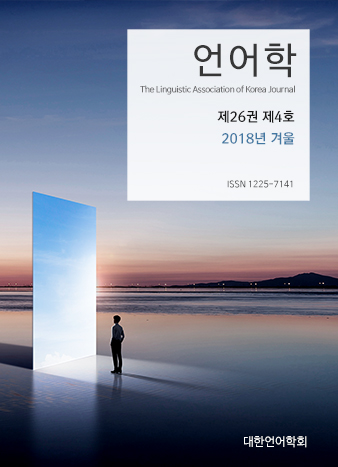대한언어학회 전자저널

-
L1 Interference in Koreans' Perception of Released Word-final Stops in English
-
Perceptual Similarity between English and Korean: Evidence from Online Adaptation
-
A Study on the Definite Article in English Based on the Rasch Model
-
Phonetic Resurrection from Ellipsis Sites: A Case from Pseudo-gapping
-
A Study of the Content Validity of Reading Comprehension Tests in NMET II
-
Labeling, Cartography, and the Left-periphery of Korean Clauses
26권 4호 (2018년 12월)
- Phonetic Resurrection from Ellipsis Sites: A Case from Pseudo-gapping
-
Jeong-Shik Lee
Pages : 55-81
Abstract
Keywords
# Pseudo-gapping # VP-ellipsis # Heavy NP Shift # Object Shift # covert QR # phonetic resurrection
References
- Abe, J. (2016). Against the “repair by ellipsis” approach: The case of Japanese multiple right dislocation. In Tae Sik Kim & Seungwan Ha (Eds.), Proceedings of the 18th Seoul International Conference on Generative Grammar. Beyond core syntax: A minimalist approach (pp. 3-16). Sogang University, Seoul.
- Ahn, H.-D. & Cho, S. (2009). On the absence of CP ellipsis in English and Korean. Korean Journal of Linguistics, 34, 267-281.
- An, D.-H. (2016). Extra deletion in fragment answers and its implications. Journal of East Asian Linguistics, 25, 313-350.
- Baltin, M. (2000). Implications of pseudo-gapping for binding and the representation of information structure. Unpublished manuscript. New York University, New York.
- Baltin, M. (2003). The interaction of ellipsis and binding: Implications for the sequencing of Principle A. Natural Language and Linguistic Theory, 21, 215-246.
- Bruening, B. (2010). Double object constructions disguised as prepositional datives. Linguistic Inquiry, 41, 287-305.
- Choi, K.-Y. (2003). Head movement in Korean finite clauses. Studies in Generative Grammar, 13, 119-142.
- Fox, D. (2000). Economy and semantic interpretation. Cambridge, MA: MIT Press
- Goldberg, L. (2005). Verb-stranding VP-ellipsis: A cross-linguistic study. Unpublished doctoral dissertation, McGill University, Montreal.
- Grano, T., & Lasnik, H. (2018). How to neutralize a finite clause boundary: Phase theory and the grammar of bound pronouns. Linguistic Inquiry, 49(3), 465-499.
- Holmberg, A. (1999). Remarks on Holmberg's generalization. Studia Linguistica, 53, 1-39.
- Huang, C.-T. J. (1991). Remarks on the status of the null object. In R. Freidin (Ed.), Principles and parameters in comparative grammar (pp. 56-76). Cambridge, MA: MIT Press.
- Ihm, I.-H. (2016). The derivational aspects of Korean non-contrastive heavy adnominal fragments: Two strategies. Studies in Generative Grammar, 26, 15-44.
- Ihm, I.-H. (2017). Remarks on the phenomena of V-PP complex in English Pseudogapping. Studies in Modern Grammar, 94, 17-40.
- Jayaseelan, K. A. (1990). Incomplete VP deletion and gapping. Linguistic Analysis, 20, 64-81.
- Kim, S. (1999). Sloppy/strict identity, empty objects, and NP-ellipsis. Journal of East Asian Linguistics, 8, 255-284.
- Kratzer, A. (1991). The representation of focus. In A. von Stechow & D. Wunderlich (Eds.), Semantik/Semantics: An international handbook of contemporary research (pp. 804-825). Berlin: de Gruyter.
- Lasnik, H. (1995). A note on pseudogapping. In R. Pensalfini & H. Ura (Eds.), Papers on minimalist syntax, MITWPL, 27 (pp. 143-164). Cambridge: MIT Working Papers in Linguistics.
- Lasnik, H. (1999). Pseudogapping puzzles. In S. Lappin & E. Benmamoun (Eds.), Fragments: Studies in ellipsis and gapping (pp. 141-174). Oxford: Oxford University Press.
- Lee, J.-S. (2002). Remnants in ellipsis constructions. Studies in Generative Grammar, 12, 169-225.
- Lee, J.-S. (2017a). Two types of VP-ellipsis in Korean. The Linguistic Association of Korea Journal, 25, 85-120.
- Lee, J.-S. (2017b). A resumption strategy for gapless multiple right dislocation. Language Research, 53(1), 23-58.
- Levin, N. (1978). Some identity-of-sense deletions puzzle me. Do they you? In Proceedings of the 14th Annual Meeting of the Chicago Linguistic Society, 229-240.
- Merchant, J. (2001). The syntax of silence: Sluicing, islands, and the theory of ellipsis. Oxford: Oxford University Press.
- Merchant, J. (2008). Variable island repair under ellipsis. In K. Johnson (Ed.), Topics in ellipsis (pp. 132-153). Cambridge: Cambridge University Press.
- Moon, G.-S. (2015). A non-isomorphism approach to null-argument anaphora in Korean. Studies in Generative Grammar, 25, 217-236.
- Otani, K. & J. Whitman. (1991). V-raising and VP-ellipsis. Linguistic Inquiry, 22, 345-358.
- Park, M.-K. (1994). A morpho-syntactic study of Korean verbal inflection. Unpublished doctoral dissertation, University of Connecticut.
- Rooth, M. (1985). Association with focus. Unpublished doctoral dissertation, University of Massachusetts, Amherst.
- Sauerland, U. (1998). The meaning of chains. Unpublished doctoral dissertation, MIT, Cambridge: MA.
- Selkirk, E. (1995). Sentence prosody: Intonation, stress, and phrasing. In J. Goldsmith (Ed.), The handbook of phonological theory, Chapter 6 (pp. 55-569). London: Blackwell.
- Takahashi, S. (2004). Pseudogapping and cyclic linearization. In K. Moulton & M. Wolf (Eds.), Proceedings of the 34th North Eastern Linguistic Society (pp. 571-585). Amherst, MA: GLSA Publications.
- Tanaka, H. (2017). Pseudo-gapping: Evidence for overt quantifier raising. University of Pennsylvania Working Papers in Linguistics, 23, 271-280.
- Thoms, G. (2016). Pseudogapping, parallelism, and the scope of focus. Syntax, 19(3), 286-307.
- Tomioka, S. (2008). A step-by-step guide to ellipsis resolution. In K. Johnson (Ed.), Topics in ellipsis (pp. 210-228). Cambridge: Cambridge University Press.